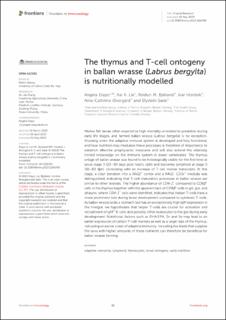| dc.contributor.author | Etayo, Angela | |
| dc.contributor.author | Lie, Kai Kristoffer | |
| dc.contributor.author | Bjelland, Reidun Marie | |
| dc.contributor.author | Hordvik, Ivar | |
| dc.contributor.author | Øvergård, Aina-Cathrine | |
| dc.contributor.author | Sæle, Øystein | |
| dc.date.accessioned | 2023-08-10T06:56:24Z | |
| dc.date.available | 2023-08-10T06:56:24Z | |
| dc.date.created | 2023-06-14T09:44:11Z | |
| dc.date.issued | 2023-05-01 | |
| dc.identifier.issn | 1664-3224 | |
| dc.identifier.uri | https://hdl.handle.net/11250/3083266 | |
| dc.description.abstract | Marine fish larvae often experience high mortality unrelated to predation during early life stages, and farmed ballan wrasse (Labrus bergylta) is no exception. Knowing when the adaptive immune system is developed and fully functional, and how nutrition may modulate these processes is therefore of importance to establish effective prophylactic measures and will also extend the relatively limited knowledge on the immune system in lower vertebrates. The thymus anlage of ballan wrasse was found to be histologically visible for the first time at larval stage 3 (20–30 days post hatch, dph) and becomes lymphoid at stage 5 (50–60 dph) correlating with an increase of T-cell marker transcripts. At this stage, a clear zonation into a RAG1+ cortex and a RAG1- CD3ϵ+ medulla was distinguished, indicating that T-cell maturation processes in ballan wrasse are similar to other teleosts. The higher abundance of CD4-1+ compared to CD8β+ cells in the thymus together with the apparent lack of CD8β+ cells in gill, gut, and pharynx, where CD4-1+ cells were identified, indicates that helper T-cells have a more prominent role during larval development compared to cytotoxic T-cells. As ballan wrasse lacks a stomach but has an exceptionally high IgM expression in the hindgut, we hypothesize that helper T-cells are crucial for activation and recruitment of IgM+ B-cells and possibly other leukocytes to the gut during early development. Nutritional factors such as DHA/EPA, Zn and Se may lead to an earlier expression of certain T-cell markers as well as a larger size of the thymus, indicating an earlier onset of adaptive immunity. Including live feeds that supplies the larva with higher amounts of these nutrients can therefore be beneficial for ballan wrasse farming. | en_US |
| dc.language.iso | eng | en_US |
| dc.publisher | Frontiers | en_US |
| dc.rights | Navngivelse 4.0 Internasjonal | * |
| dc.rights.uri | http://creativecommons.org/licenses/by/4.0/deed.no | * |
| dc.title | The thymus and T-cell ontogeny in ballan wrasse (Labrus bergylta) is nutritionally modelled | en_US |
| dc.type | Journal article | en_US |
| dc.type | Peer reviewed | en_US |
| dc.description.version | publishedVersion | en_US |
| dc.rights.holder | Copyright 2023 the authors | en_US |
| dc.source.articlenumber | 1166785 | en_US |
| cristin.ispublished | true | |
| cristin.fulltext | original | |
| cristin.qualitycode | 1 | |
| dc.identifier.doi | 10.3389/fimmu.2023.1166785 | |
| dc.identifier.cristin | 2154331 | |
| dc.source.journal | Frontiers in Immunology | en_US |
| dc.identifier.citation | Frontiers in Immunology. 2023, 14, 1166785. | en_US |
| dc.source.volume | 14 | en_US |

